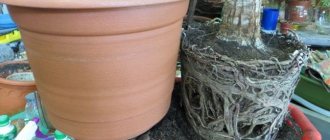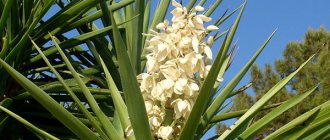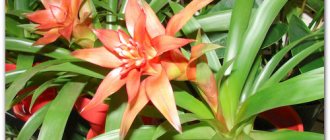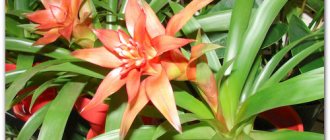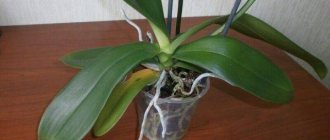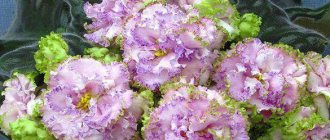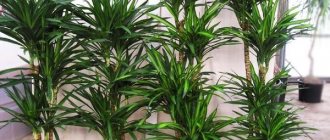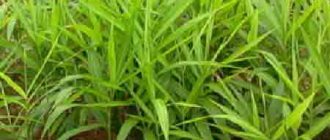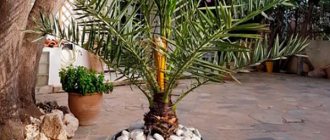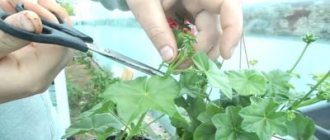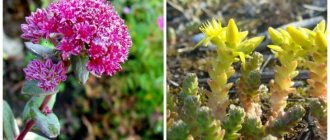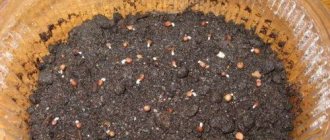Dracaena Fragrance, or Dracaena fragrant, is a tall multi-stemmed shrub with a lush crown. The most suitable conditions for its growth are found in tropical climates. With similar environmental parameters (comfortable temperature, high humidity), the plant can develop correctly in a pot.
Dracaena at home
Dracaena is suitable for growing in greenhouses, winter gardens, insulated loggias and balconies, in the halls of restaurants, hotels, it will decorate any music room of a kindergarten or school, it is an excellent plant for the office.
Any type of dracaena is well suited for growing at home, for the reason that they do not need cold wintering, such as many cacti, cycas or conifers. Artificial trees also require no maintenance.
When choosing a dracaena for your home, you need to consider how much space it will be given, because... Among the various types of dracaenas there are giant, dwarf, and quite compact forms of the plant. Young plants take up little space, but over time they grow and are not removed from the windowsill. You have to plant them in large pots and place them in the room. At the same time, variegated varieties require mandatory additional lighting. Use fluorescent lamps or LED lamps; for one large plant, 1.5 m high, you need approximately 2-3 lamps with a power of 20 W, and they should be placed no further than 20 cm from the crown, so that all parts of the plant are illuminated as evenly as possible .
The second feature of growing dracaena at home concerns large tub plants, for example, fragrant dracaena can grow to the ceiling and the span of its leaves is about 1-1.2 m. Such a specimen can only grow in a tub or a very large flowerpot, about 40-50 l. Naturally, this creates difficulties during replanting; such plants are replanted rarely, once every few years, but the top layer of soil is changed annually, especially if a coating of salts has been deposited on it. The soil must first be loosened, then removed with a scoop and topped with fresh soil or well-rotted compost.
The most unpretentious species: Dracaena marginalata, Dracaena fragrant, Dracaena derema - larger, Dracaena Godsefa, Dracaena reflexum - more compact. By the way, out of all the variety of more than a hundred species of dracaenas, about 15 species are grown as indoor plants.
Features of the flower
Dracaena belongs to the Asparagus family, despite the fact that it looks like a palm tree. Her homeland is the island of Madagascar. Decorative varieties at home can grow up to one and a half meters.
Most often in houses or apartments you can see Dracaena marginata.
Dracaena is chosen for its unpretentiousness and good compatibility. It is suitable for sunny and northern sides and does not require abundant watering.
Popular varieties include:
- Marginata;
- Reflex;
- Godzeffa;
- Deremskaya;
- Sandera and others.
Dracaena Derema.
Dracaena Godzeffa.
Dracaena marginata.
Dracaena reflexa.
Dracaena Sandera.
One of the most common options is marginata, or bordered. It looks like a palm tree. You can reproduce it yourself.
Types of dracaenas
Temperature
Dracaena prefers moderate temperatures; in summer it can suffer from extreme heat when the temperature is above 32°C. To alleviate its condition, temporarily move the pot to a cooler place, ventilate the house more often and spray the leaves. Monitor watering carefully and do not allow it to dry out. Since October, the illumination drops sharply, at home it can be very dark even on the windowsill, and if the plant is standing near a window or slightly away, high temperatures are harmful to the plant - moderate temperatures within 15-18 ° C are desirable, it can be kept on an insulated balcony up to 10 - 12°C with limited watering. If it is not possible to provide coolness, protect the plants from central heating radiators (with a screen, wet sheets on the radiator). In a warm room with a lack of light, dracaenas very quickly lose their lower leaves and decorative appearance. Therefore, the only way to preserve the plant’s health and beauty is additional lighting.
Features of home care
In order for a plant to bloom at home, it is necessary to create conditions as close as possible to natural ones. In this case, the key factors are temperature, air humidity, lighting and watering intensity, frequency of feeding and amount of fertilizer, pruning and replanting.
Temperature
The critical level is at +12°C. Below this value, conditions are created in which the bush begins to die. In winter, it is recommended to maintain the temperature within +15…+17°C. In summer, the shrub should not be exposed to temperature changes; it should not be left in the heat either. The recommended temperature regime for this period varies between +18…+25°C. The upper limit of this parameter is +28°C.
Air humidity
Most varieties of dracaena develop better in rooms where the air contains more moisture. An indicator of at least 60% is considered sufficient. Some varieties develop in more severe conditions (when the air is dry), but subject to additional moisture. In this case, the pot is placed in a wide tray with expanded clay. You can spray the plant with a spray bottle, but excess moisture must be shaken off the leaves. An alternative option is wiping with a damp cloth.
Lighting
Varieties with dark green leaves can grow in partial shade. However, in most cases it is recommended to place the pot with shrubs in the light, and not in direct sunlight. The radiation must be diffuse. Varieties with multi-colored leaves will lose their brightness in the shade.
Watering
Excess liquid in winter causes harm to the plant. From late autumn to early spring (during the dormant period), it is recommended to water the flower no more than once every 10-12 days. During the warm season, under the influence of higher temperatures, it is necessary to ensure regular watering of the bush. It is moistened 2-3 times a week: the soil is watered moderately, the leaves and stem are additionally irrigated. Intensive watering contributes to stagnation of moisture at the roots, which negatively affects the plant.
Top dressing
The frequency of fertilizer application depends on the season. For example, from spring to late autumn, plants are fed at least 2 times a month. In winter, it is enough to apply fertilizer once every 30 days. For this purpose, special additives are used for dracaenas and palm trees.
Transfer
It is not recommended to replant the plant annually: dracaena prefers consistency. However, as the shrub develops (recommendation for young plants) it is replanted after 2 years. Adult dracaena also needs to be replanted, but less often - every 3 years.
When the shrub has developed to its maximum height, it should not be replanted: it is enough to regularly change the top layer of soil, which consists of deciduous, compost, turf soil with the addition of sphagnum peat, sand (coarse-grained, purified). You can purchase ready-made soil in specialized stores by adding sand to it.
To ensure a loose soil structure, use charcoal or brick chips.
Lighting
You need a bright place, partial shade, dracaena does not tolerate direct sunlight only from 11 a.m. to 4 p.m. Many people consider dracaena to be a shade-loving plant, but in fact, it will wither in a dark place. Intense light is needed for good growth and development. Variegated forms require more lighting than forms with green leaves. The issue of lighting large plants in winter is especially acute. Such large dracaenas are bought or given as a gift to decorate rooms, but they rarely think that they need light.
Dracaena also grows well in artificial light, so arrange illumination with fluorescent lamps (for a plant about 1.5 m tall you need 2-3 lamps with a power of 15-18 W) or LED. The lamps should be placed so that the crown is illuminated most evenly. By the way, the most shade-tolerant species is Dracaena fragrant (not the variegated version). If you live in central Russia, then keep in mind that from mid-September to January, dracaena is not afraid of even the midday sun from a southern window (the sun is low and rare to cause burns).
Botanical characteristics
Dracaena Fragrances is a representative of the asparagus genus. This variety is considered one of the most demanding to care for. It grows in the western regions of Africa and reaches 6-15 m. However, the opportunity to observe the growth of a large shrub is only in natural conditions: in everyday life the height of the plant does not exceed 2 m.
Dracaena received its name due to the pleasant aroma exuded by white flowers (in translation from English “fragrance” means “aroma”).
The leaves of the plant are long, narrow, glossy, and may have veins of a different color. In the natural environment, their length is often 1 m, width - no more than 10 cm. Due to the appearance of a large number of leaves with such parameters, it appears that the crown is lush. One of the features of the plant is a border along the edge, the color of which varies from yellow to light green.
The leaves cover the stem during the first stages of development. As it grows, the lower part of the trunk opens, which makes the dracaena similar to a palm tree, but they are different plants.
In most cases, the shrub does not bloom at home. Under natural conditions, the flowers have a light shade and form a brush. The peduncle can reach 1 m in length.
Varieties of Dracaena fragrant
This group of plants includes varieties:
- Massangeana. The leaves, which are 8-12 cm long, are distinguished by the presence of a yellow stripe in the middle. There are many veins of the same color around it. The average height of the shrub when grown at home is 1.5 m. In wild conditions, the plant reaches 5-6 m. It is undemanding in care, but in summer it is recommended to keep dracaena away from dense shade and direct sunlight, and in winter - from cold and drafts.
- Victoria. The shrub differs little from the flowers of other Dracaena species. The difference between them is that the leaves of the Victoria variety are edged with a yellow stripe.
- Compacta. This is a variety that is resistant to negative external factors. However, you need to place the pot with the plant as far as possible from the windows, since dracaena develops faster in diffused light. The temperature range is quite wide: +12…+30°С.
- Lindenii. The leaves are uneven in color - there are white stripes along the edges. This is a branched plant reaching 1.6 m in height. The flower develops better at a temperature of +16…+27°C. Unlike other varieties, it can withstand dry air.
- Lemon Lime. The plant develops better under the influence of direct sunlight and prefers moderate humidity, so it is necessary to place the pot with the bush in an open area for several hours.
- Surprise. The leaves of the plant are long, curled at the ends. Along the edges there is a wide border of light green color. The crown is distinguished by its compact size and rosette arrangement of leaves. The height of the flower does not exceed 40 cm.
Watering
In summer or winter, with good lighting in a warm room (above 24°C), water abundantly after the top layer of soil has dried (about half the height of the pot). In winter, under cool conditions, especially with poor lighting, dracaenas are watered moderately or limitedly, taking into account the temperature in the room (for example, when kept at a temperature of about +8 ° C, the soil in the pot should always be almost completely dry, watering is scanty, about once every 1 ,5 months). Do not overdo it with watering - all dracaenas do not tolerate stagnation of water in the pot, as well as prolonged drying of the earthen clod. If you are in doubt about watering or it’s too early, wait. To avoid waterlogging, check whether the drainage holes are clogged with expanded clay or soil, and be sure to add drainage to the bottom of the pot when replanting. Small dracaenas are suitable for growing hydroponically.
Diseases and pests
Common diseases:
- rot (its various types) due to increased intensity of watering, low temperatures;
- hypothermia;
- yellowing of leaves due to dry air.
The most common pests on dracaena are spider mites, aphids, scale insects, and mealybugs. They must be controlled with insecticides or acaricides. The choice of product is made taking into account the type of insect or mite. Additionally, the soil moisture level should be increased. It is recommended to irrigate the plant with water from a spray bottle, since parasites do not tolerate high humidity.
Previous PlantsTransplanting dracaena at home Next
PlantsCaring for Dracaena dereme at home
Fertilizer
During the growth period from April to August, dracaenas are fed every two weeks with complex fertilizers for indoor plants. The ideal ratio of the main macroelements in NPK fertilizer is 3:1:3, somewhat worse than 3:1:2. It is quite difficult to select fertilizers, but you can, for example, “Stimulus for decorative deciduous organomineral fertilizer” - NPK 3: 1.5: 2 and microelements S, Mg, Fe, Mn, Cu, Zn, B, Mo. Not everyone from the Agricola line is suitable, perhaps only Agricola for ficuses, it has an NPK of 24:11:18, an additional 0.5% MgO and trace elements, if you recalculate the NPK ratio, it is approximately 3:1.38:2, 25 - will completely satisfy the needs of dracaena. Other fertilizers for deciduous trees have too high a dose of phosphorus; fertilizing with such fertilizers will lead to the formation of necrotic (dark brown) spots along the edges of the leaves.
Don’t look for special fertilizers for dracaenas, look for a suitable NPK ratio, for example, Bona Forte also has fertilizer for ficuses or for decorative deciduous trees - but they also contain too high a dose of phosphorus. But Bon Forte has a liquid Lawn Fertilizer - this is a complex mineral fertilizer, with NPK 7: 3.5: 7 - practically what we need + 7 microelements: Boron, iron, manganese, zinc, copper, molybdenum, cobalt.
All you need to do is find a fertilizer with the correct NPK ratio and convert it to the required amount of water. For example, fertilizer “for lawns” from Bon Forte will need to be diluted twice as much as the dosage recommended on the package, and fertilizer “Stimul” must be diluted according to the instructions.
How to replant dracaena
Dracaena should be replanted at the beginning of a new growth cycle - in spring, early summer. Young plants need to be replanted annually, as plants grow vigorously, quickly using up nutrients. Old dracaenas (over 6-7 years old) can be replanted every two to three years.
It is better to compose the soil for dracaena yourself from various components: 1 part turf soil, 1 part leaf soil, 1 part rotted manure (compost) and 1 part coarse sand (more precisely, fine gravel 3-4 mm in size).
If you use soil for dracaenas from a store, choose trusted manufacturers (for example, Terra Vita Living Earth). But to such soil it is advisable to add 1/5 of the volume of fine gravel or coconut shavings (chips) and the same amount of compost (humus). But in any case, the soil must be sterilized.
The root system of dracaenas is relatively small and rather superficial; it does not tolerate waterlogging, so the pot has high drainage. You can plant dracaenas in purchased soil for palm trees and other large plants, or in universal soil. However, it is a good idea to add loosening elements (fine gravel, coconut substrate) to such soil in an amount of 1/5 of the volume of the pot.
Which soil should I choose?
Store-bought soil for palm trees and cacti is suitable for growing dracaena. If desired, you can prepare it yourself at home.
To do this, mix the following ingredients in equal proportions:
- sand;
- vermiculite;
- mid peat;
- vermicompost;
- compost.
It is advisable to use a mixture that includes leaf and turf soil.
Flower growers also recommend not digging up the substrate to check the formation of roots. This way you can damage the unformed root system.
Rooting of cuttings lasts 1–2 months . Young shoots usually appear in the second or third month. If time has passed, and the plant has not taken root, it does not have new shoots, then it means you did something wrong. It is advisable to repeat the procedure.
First, the buds will swell on the cuttings.
Then the first leaves will appear.
conclusions
Dracaena is not only a beautiful, but also an easy to care for indoor plant. Reproduction can be done independently, following simple rules.
Marginata can be propagated from apical or stem cuttings.
The first method is suitable for plants that have reached a height of 30 cm or more, the second - for flowers whose tops have begun to fade.
Special care requirements for dracaenas
Dracaenas are very sensitive not only to chlorine contained in tap water, but also to elements such as fluorine and boron.
To get rid of chlorine, just let the water sit for 24 hours. However, if there is an excess of fluoride in tap water in your area, settling will not help; filtering reduces its content to some extent, but only slightly. Only filters with reverse osmosis are better at purifying water from this chemical element. If you do not have such a filter, the best solution is to water your dracaenas with distilled water. In addition, it is important to avoid fertilizers and soils containing superphosphates - they have a high fluorine content. Perlite and vermiculite are also prohibited for dracaenas - they contain high levels of fluoride.
Acidity is also important, so that plants do not get fluoride poisoning, maintain the soil pH in the region of 6-6.5 units (the amount of fluoride bound by the soil increases as the pH decreases). When the acidity pH is below 6.0, dracaena may experience leaf spotting, necrosis of the tips and edges of leaves - a deficiency of Potassium, possibly simultaneously with the accumulation of fluoride. Sometimes these are single brown spots located closer to the edges. At a pH above 6.5, iron deficiency occurs and appears as chlorosis, primarily on young leaves.
How to propagate dracaena
Dracaena - propagation Dracaena can be propagated by seeds and cuttings (pieces of stem). In any case, propagation is best carried out from the end of February to May, so that the seedlings or rooted cuttings have time to get stronger by winter.
Before planting, seeds should be soaked for a day in water at room temperature. It is possible, but not necessary, to add growth stimulants - epin or zircon - to the water. Plant the dracaena in a small pot (8-10 cm in diameter), to a depth of no more than 1 cm. You need to add expanded clay drainage to the bottom of the pot. The soil is a universal peat or soil for seedlings; you can add a tablespoon of coconut substrate (from briquettes) to it. Be sure to sterilize the soil! Plant the cutting and water the soil in the pot. Now you need to create increased humidity - place the pot in a transparent bag or cover it with a jar. Ventilate twice a day.
Germination takes on average 2 weeks, sometimes longer. But even if the seeds have not sprouted within a month, do not be discouraged, they can linger for up to three months. Caring for crops is like caring for any other flowers - it is important not to overwater them or overdry them. The soil should be constantly moderately moist. If they stretch noticeably, organize additional lighting.
Dracaena, which has become elongated and bald in the lower part of the trunk, is most often propagated by apical cuttings or pieces of a trunk at least 10 cm long. In spring, cuttings take root well in water (1 liter of boiled water, add 1 tablet of activated carbon). The roots appear within 1-3 months. When they grow to a length of 5 cm, you can plant the dracaena in a pot. Rooting dracaena in the ground using heteroauxin and heating the soil is also practiced, but only small cuttings. In this case, the soil must be sterilized, and the plant itself must be placed in a ventilated greenhouse. By the way, at the place where the cuttings are cut, new shoots from the lateral buds will appear on the mother plant.
How to take a shoot from a dracaena
To propagate dracaena at home vegetatively, you need to follow some rules. The operation is simple, but the stem of the crop easily rots. If you make a mistake, you will have to start all over again, cutting off the lower part of the long shoot, leaving the short one to be thrown away.
Recommended time
The best time for cuttings, if the flower is propagated as planned, is spring, immediately after leaving the dormant period, when new leaves begin to form intensively. Then it will take 1-1.5 months to root. It happens a little slower in the summer.
It is better not to breed in winter. Unless I had to trim and replant the dracaena with rotting roots. Here the choice is small - throw it away or try to root the shoots that have been stripped to healthy tissue.
Suitable size
Dracaena reproduces at home by apical shoots of about 15 cm. If they are several centimeters larger, it’s not a big deal. But too long ones need to be divided.
A side branch cut at the base of the trunk to propagate the flower is used in its entirety or divided into parts at the request of the owners. At a bend, roots form easily; sometimes their rudiments are already present at the point of attachment to the older shoot.
The crop can be propagated by non-leafy cuttings if they are cut into pieces from 5 to 20 cm. It is better not to make them larger or smaller.
Usually, when pruning dracaena, a column of 10-20 cm is left. This is not necessary. The height is permissible as high as desired; the owners do not have to cut the flower at all, but tie it up or bend the trunk. Or leave the stump at least 5 cm thick - then it will seem that 2 plants are coming out of the ground at once.
How to make a cut
In most crops, it is correct to make an oblique cut, while in dracaena it is correct to make a straight cut. Why? This requires basic knowledge of botany.
The trunk of Dracaena is covered with constriction-like scars left by fallen leaves. These are the internodes, the areas where the cut should be. It is simply impossible to make it oblique.
Cutting process
It is better to consider the propagation of dracaena by cuttings using the example of rejuvenation of an adult, well-branched plant. Step-by-step instruction:
- Cut off the top at the desired height. This will be a trunk, on the top of which several sleeping buds will wake up. If you are lucky and the operation is performed during a period of active growth, you will get a double or triple fork.
- On the mother plant, the wound is covered with garden varnish or balm.
- The first propagation material is obtained from the crown with leaves - cut at a height of 15 cm. If plates are located throughout the entire area, the lower ones are cut off.
- Sometimes the stem has not only an apical fork, but also lateral branches. To propagate, they are cut close to the main shoot, perhaps with a small piece of bark. Such shoots produce roots faster than others.
- The same is done with offspring - tufts of leaves that extend from the trunk and have not had time to grow their own stem.
- The main shoot and the side shoots that are too long to propagate are cut into pieces of 5-20 cm.
- The stem pieces are first dried for 2 hours in the open air at room temperature away from direct rays to form callus.
- The wound surface is treated with crushed activated carbon or a root formation stimulator.
Reproduction by layering
The operation has no advantages over cuttings. But it’s easy to do on dracaena; you can practice it before propagating another flower by layering. Step-by-step instructions for propagation by layering:
- Select a woody section of the stem.
- Several longitudinal parallel cuts 1.5-2 cm long are made.
- Wrap in wet sphagnum moss and cellophane. Often the flower is germinated in a small plastic container, cut on the side. It is put on the area with damaged bark, filled with moss, and moistened as needed.
- When the roots appear and reach 2-5 cm, the branch is cut off and planted in a pot filled with substrate.
Dracaena turns yellow
- Brown, dry tips or edges of leaves - if the leaves are elastic, the cause is too dry air or insufficient watering.
This dracaena has two problems: too much watering and too large a pot, in which the soil turns sour and the roots rot. - Limp, drooping leaves of dracaena can be a sign not only of a regular flood, but also of hypothermia, especially if the root system was damp (a cold night on the balcony, transportation from the store to home).
The main problem with this dracaena is the lack of light, so the lower part of the trunk becomes bald, and the crown reaches towards the light. - Yellowing of leaves - if the leaves are elastic and not flaccid, then the cause may be insufficient watering, lack of nutrition, if they have not been replanted for a long time. If the air is too dry, directed (from the battery), then in addition to yellowing, there may be dry round spots on the leaves, usually gray.
Dracaena fragrant is very shade-tolerant, and such yellowing of the leaves is evidence of a violation of watering (overdrying, overwatering, or, what happens more often, first severe drying out, and then excessive watering).This dracaena was frozen - the leaves turned black from contact with cold air during ventilation. Hypothermia is especially dangerous when the soil in the pot is damp.
This dracaena was watered very diligently - a sure sign of waterlogging and root rot is the death of the top; usually at this stage the plant cannot be saved.
- The lower leaves turn yellow and fall off - it is typical for dracaena to lose the lower leaves, while the upper part of the plant remains leafy. But it can be considered more or less normal for the trunk to be exposed 1/3 from the bottom. If a large part is exposed, then it is worth considering whether the plant has enough light.
- Light large dry spots on the leaves, then turn brown, with clear boundaries - too intense lighting and sunburn. Dracaena needs shade from direct sunlight during the hottest hours of the day.
How to save dracaena if it is sick. If there are signs of a lack of lighting, then move the plant to a brighter place or provide additional lighting with fluorescent lamps.
If the plant suffers from dry air, then, firstly, you can cover the radiators with a damp sheet. Secondly, place the pot with dracaena on a tray with wet pebbles or sphagnum moss. But this will not help a large plant; the only way out is a humidifier.
If the dracaena was flooded, then the degree of its survival depends on how badly the roots were damaged (rotted). In any case, you need to try to save the plant - remove it from the pot, shake off the damp clods of earth and dry the root ball with newspapers or toilet paper. Then plant in dry soil and do not water for about 2 days, then water carefully.
Varieties of Dracaena
The genus includes more than 40 species, of which a dozen are used to decorate rooms. They are varied in appearance, shape, parameters, and foliage color. The most common types of plants are:
| Dracaena marginata | It is also called bordered due to the presence of a border framing the edges of the leaves. It is one of the most common forms with green leaves and a red stripe on them. The leaves are long, can grow up to 70 centimeters, and are narrow, slightly curved. At home it practically does not bloom. The peak of decorativeness comes in adulthood, when the trunk is completely freed from the lower leaves, and the top is decorated with a bunch of leaves unique in appearance. The older the specimen, the more it resembles a palm tree. It can grow up to 250 centimeters in length. If the leaves are slightly damaged, the plant may begin to grow poorly, so you need to choose the right place for the flower. |
| Dracaena fragrans | Diverse in parameters (can be dwarf up to 20 cm and tall - up to one and a half meters), color of foliage and stripes. Yellowish-green or yellow foliage is found. The leaves are wider than those of the previous species, curved in an arc. The flowers are white or pale green. |
| Dracaena deremensis | It belongs to the category of tall plants; even in a room it can grow up to 3 meters. The trunk is thick and woody. The lower leaves dry out and fall off, exposing the trunk and leaving characteristic marks on it. The leaves reach half a meter in length and 5 centimeters in width, widening towards the base. The color is dark green, variegated. In young plants the leaves grow upward, in older plants they droop. The flowers are dark red with a white center. The smell they give off is not very pleasant. The fruits are berry-shaped, orange. It rarely takes root at home. |
| Dracaena Sanderiana | The shoots can be found in specialized stores under the name “bamboo of happiness.” But this plant has nothing to do with bamboo. Graceful trunk, small height (up to 1 meter), long thick leaves, slightly curved, green with gray or white stripes. Practically does not bloom. It looks great in small spaces. |
| Dracaena reflexa | It is an ornamental plant that is very demanding to care for. The three-meter trunk is straight, so it needs to be supported. The leaves are small, variegated, arrow-shaped, green. A yellow stripe runs along the edge of the leaves. Prefers rooms with high humidity rather than dry ones. |
| Dracaena godseffiana | Rarely found among indoor plants. More like a small shrub with straight, thin bases pointing upward. The leaves are oblong, eleptic in shape, slightly pointed and grow up to 5 pieces. The leaves are green on top with light spots. Godzefa blooms with fragrant, greenish-yellow flowers. |
| Dracaena arborea | Look great in any high room. The tree-like representative reaches a height of up to 12 meters. The leaves are long (up to 1 meter) and quite wide (up to 8 centimeters), green in color. |
| Dracaena hookeriana | Grows no more than 2 meters. Sometimes the trunk may split in two. Garden varieties have been developed. Grown in greenhouses with warm temperatures. The leaves are up to 80 cm long and up to 5 cm wide, covered with skin. The base is wavy and slightly tapered. The edges are white. |
Rules for caring for Dracaena
The plant is quite capricious, and the conditions in which other indoor plants can grow and develop may not be suitable for it. Recommendations from experts in the industry should be taken into account.
Lighting
Dracaena grows where there is a constant “sea” of sunlight. She doesn't just love the sun, she needs it. However, it is uncomfortable for it to develop in direct sunlight, since in nature it is shaded by tropical forests. A great place for a flower would be in close proximity to an east window or next to a south window. When purchasing Dracaena with variegated foliage, it is worth considering that it needs more diffused lighting. In winter, Dracaena needs artificial lighting.
Temperature
A warm room is preferable to a plant than a hot one. In summer, it feels great at temperatures from +20 to +25 degrees, but for a short time it can develop at higher temperatures. During the winter months, the room temperature should not fall below +15 degrees.
On warm days, Dracaena can be taken outside or onto the balcony. The only condition is the absence of drafts.
Soil moisture
Dracaena loves water very much, so you shouldn’t skimp on it when watering. Despite the strong love for water, you should not overdo it, as the earth may bloom. If water begins to stagnate in the root system, the flower may disappear. Therefore, it is necessary to determine for yourself the regularity and volume of watering. In the winter months, Dracaena should be watered with settled warm water with longer breaks than in the summer.
Spraying rules
The home palm not only loves water, it prefers to be in a room with sufficient humidity. Dracaena loves water showers very much. Rare species can tolerate constant dry air. The plant should be regularly sprayed with warm water or wiped with a soft sponge or flannel cloth.
If the air is too dry, the tips of the leaves will begin to dry out and turn yellow. Brownish spots may even appear. This indicates that the plant needs spraying.
Quality of soil mixture
Dracaena is completely indifferent to the composition of the soil. She doesn't care what kind of soil she is placed in. But the optimal composition for a plant is considered to be a mixture of leaf soil, turf, sand and peat. The main requirement for soil is sufficient looseness and water permeability. The bottom of the pot must be covered with a significant layer of drainage.
Fertilizer application
Dracaena needs to be fed, but not too often. The optimal period is every week or twice a week. Can be fed once every 30 days. Most of all, the plant is happy with complex liquid mineral fertilizers, which are applied from April to August.
Reproduction
Transplantation and propagation actions usually coincide. Basically this happens once every three years. Young Dracaena is replanted annually, and old one every 5 years. During the transplantation process, many unnecessary shoots remain, which can be used for germination and rooting. The upper part of the plant takes root better than the rest. If the tree has grown to the point where the trunk is completely free of lower leaves, it should be rejuvenated. This occurs by cutting and rooting the top.
Air layering and cuttings are also methods of propagation. In order for the young to take root, it must be placed in a soft earthen mixture. You can add some moss to the soil.
Pests of dracaenas
Most often, dracaena is affected by scale insects, thrips and mites.
Scale insects look like brown plaques on the surface of leaves and stems and suck out cell sap. Leaves lose color, dry out, curl and fall off.
Thrips look like small black rods (about 1 mm long), but their excrement is more often noticeable - sticky black droplets. Light dots and streaks appear on the leaves, they quickly merge into large spots. As a result, the upper side of the leaf becomes grayish-brown, with a characteristic silvery sheen.
Control measures. Systemic insecticides help against thrips and scale insects (as well as whiteflies and aphids), especially if the plant is large and difficult to spray thoroughly. The drugs of choice are Aktara and Confidor. These drugs need to be watered on the ground, and they are the safest for humans. You can also spray with contact or enteric contact preparations (Fitoverm, Decis, Actellik, Inta-Vir).
Mites are difficult to detect on a plant until they have formed a huge colony. But if you look closely, on the underside of the leaf you can see a whitish husk, similar to dandruff - the skins of mites and larvae. The leaves of the dracaena become discolored, turn yellow and fall off, and when exposed to the light of the leaf, you can see pinpoint punctures, as if the leaf had been pricked with a needle.
Control measures. Only with the help of acaricide preparations, all of them are intended for spraying. Small dracaena bushes can be saved from ticks if you give them a hot shower: take the plants to the bathroom, lay them on their sides and water them with hot water from the shower for about 2-3 minutes. The water should be approximately 50-55 degrees. After 5-7 days, repeat the dousing from the shower.
You can’t take large plants into the bathroom; you have to use pesticides. But if you are afraid to use poisons (for example, you have children at home), you can try spraying dracaena leaves with a solution of green soap. The solution does not smell, but the effect is rather weak; there is no need to wash off the green soap, leave it until it dries.
Be sure to increase the humidity in the room; mites multiply intensively in dry air and high temperatures.
Read more about pests of indoor plants in the pests section.
By the way
In the summer, it is better to place the dracaena in the garden or on the balcony, providing it with shelter from the wind and bright sun. Uniform lighting from all sides in the open air promotes better foliage of the plant.
But before you bring the plants back into your apartment, make sure it is free of pests.
In appearance, Dracaenas are often confused with Cordylines. To distinguish them you will have to remove the plant from the pot. In dracaenas, the roots are even and smooth in color from orange and yellow to light brown, while in cordilina they are white.
In addition, cordylines never form root suckers.
Dracaenas with wide leaves require more abundant watering during the growth period than dracaenas with narrow leaves, since their leaves evaporate more moisture.
It should also be noted that fragrant dracaena, the most broad-leaved of all species, often suffers from mechanical damage. Its leaves are easily bent and cracks and scars form on them.
And dracaenas with narrow leaves (for example, Dracaena marginata) are loved by cats and cats.
Therefore, do not place large plants somewhere in the passage, next to the door. And grow special grass for the cat.
Dracaenas respond very well to periodic loosening of the top layer of soil in pots in spring and summer. This improves soil aeration. If the top layer of soil in a pot with dracaena is covered with a white crust - these are deposits of salts from water and soil, you need to remove the top layer of soil and add fresh soil. And for irrigation use boiled water.
When transplanting dracaenas, add pieces of charcoal (birch) coal and expanded clay (fraction 3-5 mm) to the fresh soil mixture in addition to sand. For a bucket of earth, three handfuls of coals and 0.5 liters of expanded clay. Pieces of coal prevent the development of rotting processes, and brick chips increase the looseness of the soil.
